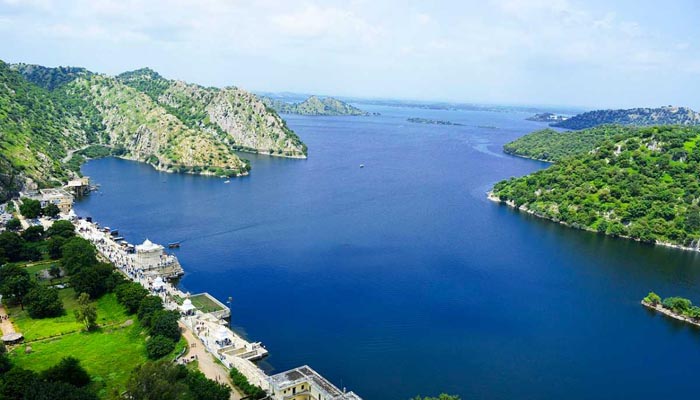Jaisamand Lake, also known as Dhebar Lake, is Asia's second largest artificial water body. Located at a distance of 48 Km from the city of Udaipur, it was built in 1685 by Maharana Jai Singh. There is a massive dam constructed on this lake which also features a Shiva temple. A summer palace of Udaipur queens forms a backdrop to this lake giving it a regal touch. This attraction near Udaipur is famous for its six intriguing cenotaphs that carved out of marble at the embankment of the lake. The north comprises a fascinating palace with a huge courtyard whereas to the south of this lake is a pavilion with 12 beautiful pillars. You can come here to relax in the peaceful surroundings that this place offers. Its proximity to a sanctuary makes it a habitat for various exotic birds and animals. This lake comprises seven islands, one of which is still inhabited by a local tribe.
Spanning across an area of about 100 sq.km., Jaisamand Lake is the second largest artificial lake in the country after Govind Ballabh Pant Sagar. It is surrounded by the Jaisamand Wildlife Sanctuary which is home to a variety of rare animals and migratory birds. The summer palaces of Queens of Udaipur also form a beautiful backdrop. Situated in seamlessly beautiful surroundings, it is a place to rejoice. On its marble dam, there are six cenotaphs and a temple dedicated to Shiva at the centre. The temple is proof that the people of Mewar were conscious of their worship rituals. Locals know it by the name of Dhebar Lake as well.
The lake was constructed by Maharaja Jai Singh in the 17th century, to be more precise in 1685, while he was building a dam across the Gomti river. The 'Ocean of Victory', as its name suggests, was inaugurated on June 2, 1691. It has three islands which are inhabited by the tribe of Bhil Minas. The two bigger islands are called Baba ka Magra and the small island is known as Piari. To its north, the lake has a palace with a courtyard and a pavilion of 12 pillars to its south. There is also a massive bund at the height of over 1200ft on the lake. The Jaisamand lake is clean, beautiful and a nature lover's real paradise. Away from the turmoil of the city, this place of utmost peace is a must visit.
Architecture of Jaisamand Lake
The Jaisamand Lake comprises of three islands which are inhabited by the tribes of Bhil Minas. The two of the bigger islands are known as Baba ka Magra, and the smaller island is named as Piari. The lake is 9 miles (14 km) in breadth, 30 miles (48 km) in circumference, 102 feet (31 m) in depth and has marble staircases leading into the water.
The marble dam has six exquisite cenotaphs with a Shiva temple built in the centre. The Shiva temple and the Chattris add grace to the beauty of this lake. On the northern end of the lake is a palace while the southern has a huge pavilion with 12 pillars. The hills on the south have presented a mind-blowing view from the palace. These palaces were constructed for the Queens. Encircled by a wonderful environment this lake is a place of natural heaven. From the remaining 11 islands on the lake, some provide a home to migratory birds and other animals. They form a nearby wildlife sanctuary.
Activities at Jaisamand Lake
The gorgeous lake provides a pollution-free atmosphere away from the hustle and bustle of the city and helps tourists escape into a mode of peaceful bliss for a few moments. Two grand palaces exist on the top of nearby hillocks which provide exquisite views of the Jaisamand Lake. While admiring the beauty of the place, one can also take boat rides and paddle. Equipment for various water sports is also available. Sunset Point, the newest addition to the area, is an exciting attraction for photography enthusiasts.
How to Reach Jaisamand Lake
It is located at a distance of 50 km from the central city of Udaipur and takes around an hour to reach. Hence, local buses, taxis, auto-rickshaws, and tongas can be hired from any part of the town to reach the Jaisamand Lake. Moreover, regular buses operate from district headquarters of Udaipur to Jaisamand.

